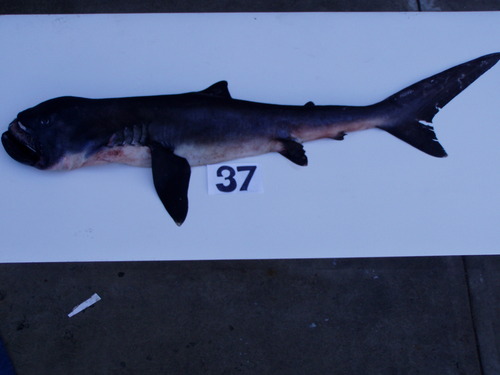
Megamouth Shark
The Atlantic bluefin tuna (Thunnus thynnus) is a magnificent and highly migratory species renowned for its size, speed, and commercial value. It plays a crucial role in the marine ecosystem and is a top predator.
Unknown 100 years
Lifespan
440 - 550 cm
Length
Least Concern
Conservation Status
2 km/h
Swimming speed
Filter Feeding, Planktivorous
Diet
Vertical Migration
Migration
Appearance Overview
The Atlantic bluefin tuna is a large, streamlined fish with a metallic blue body and a silvery belly.
Coloration
Dark metallic blue on top, silvery-white underside
Body Shape
Torpedo-shaped, built for speed and endurance
Fins
Two dorsal fins, the first depressible into a groove; small finlets run down the back and belly to the tail
Keel
Strong lateral keel on the caudal peduncle
Length
Up to 13 feet (4 meters), commonly 6.5 feet (2 meters)
Weight
Up to 2,000 lbs (900 kg), commonly 550 lbs (250 kg)
Diet
Carnivorous; feeds on a variety of fish (such as herring, mackerel, and hake), squid, crustaceans, and eels.
Feeding Behavior
An opportunistic predator, the bluefin tuna uses its speed and agility to hunt. It often feeds cooperatively, herding and capturing prey in groups.
Social Behavior
Highly migratory and forms large schools, especially during spawning season. Schools are often size-based.
Commercial Relevance
Extremely high value, particularly in the Japanese sushi and sashimi market, where a single fish can fetch hundreds of thousands of dollars.
Conservation measures
Subject to international fishing quotas and management plans through organizations like ICCAT. Efforts include minimum size limits, seasonal closures, and monitoring programs.
Status
Endangered (IUCN)
Threats
Overfishing (historically and ongoing, though regulated), bycatch in other fisheries, climate change affecting prey distribution and spawning grounds.
Habitat Distribution
Depth Range
Surface waters to depths of over 3,000 feet (1,000 meters), depending on the season and prey availability.
Geographic Range
Found throughout the North Atlantic Ocean, including the Mediterranean Sea. Two main spawning grounds: the Mediterranean Sea and the Gulf of Mexico.
Preferred Environment
Primarily pelagic (open ocean), but also found in coastal waters. Prefers temperate waters.
Reproduction and Life Cycle
Breeding Habits
Spawns in warm waters, primarily in the Mediterranean Sea and the Gulf of Mexico. Spawning occurs in large aggregations.
Development Stages
Eggs are pelagic (free-floating). Larvae are planktonic and develop rapidly. Juveniles grow quickly, reaching significant size within their first year.
Fecundity
Highly fecund; a large female can produce up to 30 million eggs per spawning season.
Maturity Age
Reaches sexual maturity at around 4-8 years of age, although this can vary depending on location and environmental conditions.
Faqs about Megamouth Shark
How long do Atlantic bluefin tuna live?
Atlantic bluefin tuna can live up to 40 years, though this is becoming rarer due to fishing pressure.
How fast can Atlantic bluefin tuna swim?
They are among the fastest fish in the ocean, capable of bursts of speed up to 40-60 mph.
Are Atlantic bluefin tuna warm-blooded?
Yes, they are warm-blooded, which allows them to maintain a higher body temperature than the surrounding water, aiding in muscle efficiency and speed.
What is the biggest threat to Atlantic Bluefin Tuna?
The main threat is overfishing which has significantly depleted their population.
How far do Atlantic Bluefin Tuna migrate?
Atlantic bluefin tuna are highly migratory and cover vast distances across the Atlantic Ocean, moving between feeding and spawning grounds.
Copyright @ Nature Style Limited. All Rights Reserved.
 English
English